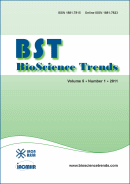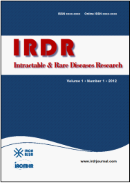Drug Discov Ther. 2009;3(6):287-295.
Development of implants for sustained release of 5-fluorouracil using low molecular weight biodegradable polymers.
Hanafy AFH, El-Egaky AM, Mortada SA, Molokhia AM
Anticancer drugs have poor efficacy especially against solid tumors that hinder drug penetration into the tumor. Thus, the dose has to be increased, but toxicity is a limiting factor. Local administration of a polymeric biodegradable poly-L-lactic acid (PLA) and poly(L-lactic acid-co-glycolic acid) copolymer (PLGA) implant containing an anticancer drug may be an acceptable method of concentrating the drug near the tumor site. This work sought to synthesize low molecular weight PLA and PLGA by polycondensation to yield polymers with good physical properties to make them suitable for use in implantable therapy. The synthesized polymers were characterized by determining their molecular weight, melting point, and percentage crystallinity using DSC. Fourier transformationinfra red spectrum (FT-IR), nuclear magnetic resonance (NMR) and specific optical rotation measurement were also used to characterize the synthesized polymers. Morphological characteristics were assessed using scanning electron microscopy (SEM). Implants were manufactured using compression (C) and injection molding (IM) and were loaded with 12 mg 5-fluorouracil (5-FU) per 120 mg implant. In vitro release patterns of all implants were assessed in phosphate buffered saline pH 7.4 (PBS 7.4) at 37°C. Factors affecting the release of 5-FU from implants were the polymer species, manufacturing technique, drug particle size, drug concentration, implant dimensions, and coating of the implant. Implants prepared with PLGA had significantly faster release of 5-FU than those prepared with PLA. Those manufactured using compression had significantly faster drug release than those prepared by injection molding. A PLA implant that contained 12 mg 5-FU/120 mg with a diameter of 0.3 cm and that was loaded with a drug particle size smaller than 150 μm and prepared by injection molding and then subsequently coated with PLA had the longest release period of 45 days.







